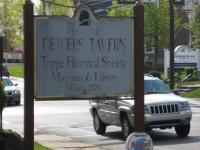After the Declaration of Independence was adopted by the Continental Congress on July 4, 1776, the task still remained to actually tell the people of the American colonies what had been declared on their behalf. In Reading, Pennsylvania, the public reading of the Declaration of Independence was undertaken by Henry Vanderslice, the sheriff of Berks County. Vanderslice must have been eager to undertake the task, for soon after he would volunteer for the Revolutionary Army at the ripe old age of 51.
Henry was born in 1726 to Anthony and Martha (Pannebecker) Vanderslice, and trained to be a surveyor with his grandfather Hendrick Pannebecker (also the ancestor of Pennsylvania Governor Samuel W. Pennypacker). In 1774 he was appointed Sheriff of Berks County, and it was in that capacity that he publicly read the Declaration of Independence to the county on July 8, 1776. During the Revolutionary War Vanderslice served under General Muhlenberg as wagon master (in the equivalent of today's Quartermaster Corps), provisioning troops as far away as New Jersey and including Valley Forge. After the war Vanderslice returned to surveying, working as Deputy Surveyor and then Surveyor for Berks County. He died in 1797.
If you would like to learn more about Henry Vanderslice, you could read a transcription of his diary, 1777-1778, as it appears in the book "Van der Slice and Allied Families" by Howard Vanderslice (Los Angeles: Neuner Corp., 1931). But on a recent visit to the Historical Society of Trappe, Collegeville, Perkiomen Valley, we learned something that Howard may not have known--Henry Vanderslice had more than one diary!
The journal of Henry Vanderslice at the Historical Society of Trappe, Collegeville, Perkiomen Valley dates from 1777 to 1780. It has more in the way of accounts and receipts than personal reflections, but it is nonetheless an important accompaniment to the first diary. Plus, there is plenty of logistics data to pique the interest of Revolutionary War buffs!
There is a very special feeling of excitement and satisfaction that comes when a historic manuscript, locked away in someone's basement or attic for centuries, is suddenly discovered. That was how Pennsylvania German historian Arthur D. Graeff felt in the 1920s when he discovered the Vanderslice journals in the possession of "hermit antiquarian" George Von Nieda.* But my co-surveyor Michael and I experience an echo of that feeling when we come across an especially interesting manuscript tucked away in a small historical society. Although the journal is already safely housed and preserved in archival storage at the Historical Society of Trappe, Collegeville, Perkiomen Valley, we are thrilled to do our small part by helping to spread the word about this interesting resource through the HCI-PSAR project.
See all finding aids for The Historical Society of Trappe, Collegeville, Perkiomen Valley
Sources Consulted
Graeff, Arthur D. "Berks County Sheriff in Washington's Army; Small Leather Book Tells Historic Narrative." Reading Eagle, August 28, 1927.
*Graeff, Arthur D. "George Von Nieda - Hermit Antiquarian." Die Shilgut fun der Tulpehocken 1:VII (1975): p. 3-8.
Graeff, Arthur D. "Henry Vanderslice." Die Shilgut fun der Tulpehocken 1:VII (1975): p. 9-23.
Mertz, Patricia Schearer. "Who Was Henry Vanderslice? Berks sheriff, surveyor aided Revolution." Reading Eagle, July 2, 2006.
Vanderslice, Howard. "Van der Slice and Allied Families." Los Angeles: Neuner Corp., 1931.

